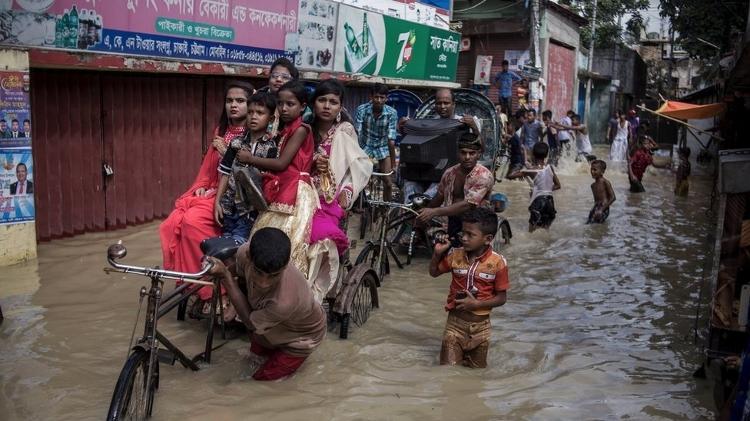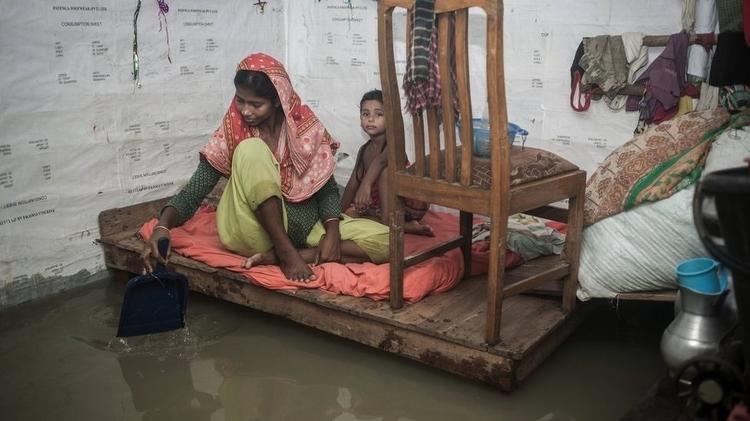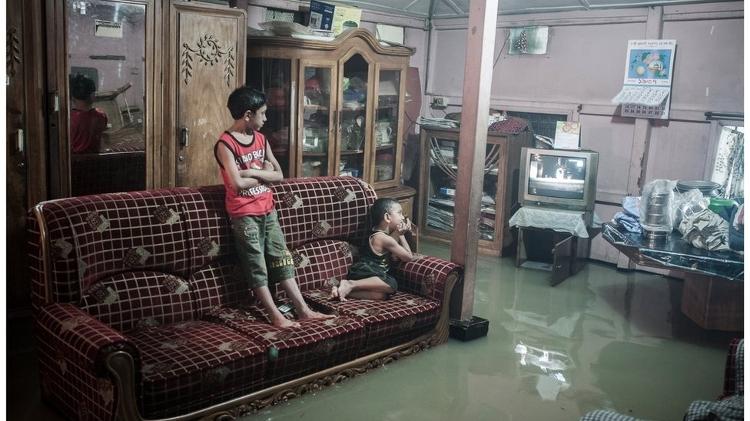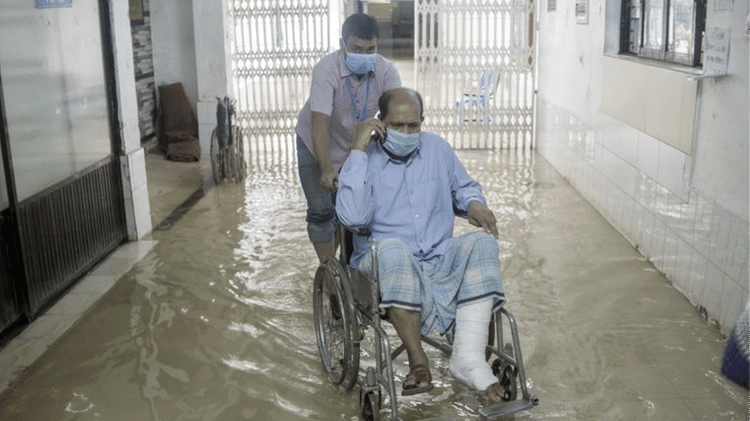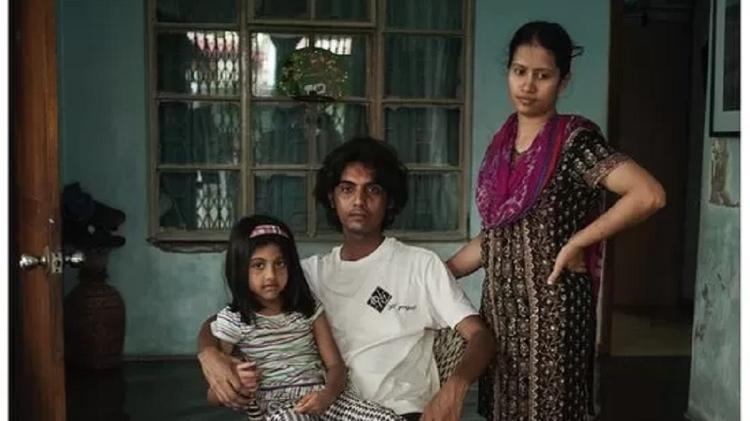Its geographical location and topography make Bangladesh one of the most flood-prone countries in the world.
This also means that the country is particularly vulnerable to rising seas, one of the most serious consequences of climate change.
For millions of residents, ocean progress is already a reality.
Jashim Salam has seen flooding his entire life, but what the independent photographer witnessed in 2009 looked strangely different.
The waters that flooded Chaktai, the neighborhood of Chittagong city where he was born and raised, continued to rise even after the rain stopped.
“We were used to flooding from heavy rains or hurricanes,” Salam told the BBC.
“But I saw many houses flooded that day, and it didn’t rain – the sun was shining.”
The flood was caused by a tidal surge in the waters of the Bay of Bengal, and the Chittagong coast, one of the world’s oldest ports, was particularly at risk.
Salam, camera in hand, started taking pictures of the situation in the streets of Chaktai.
low country
Documenting rising waters would take much more time for Salam: The floods were a sign that rising seas were becoming a constant concern for Chittagong and the rest of Bangladesh.
Bangladesh is a low-lying country, which means that most of its land is near or even below sea level.
This makes it particularly vulnerable as warmer global temperatures add water from melting ice sheets and glaciers and expand seawater as it warms, causing sea levels to rise.
In the case of Chittagong, there is an additional complication: the coastal city is sinking.
sinking cities
In March this year, the journal Geophysical Research Letters published an analysis of satellite data from 99 coastal cities around the world.
Have the researchers calculated how much these cities were affected by the so-called land subsidence? A process by which soil is settled and compacted through activities such as groundwater extraction associated with population growth and rapid urbanisation.
They found that between 2015 and 2020, 33 cities sank by more than one centimeter per year, which is five times the global sea level rise rate estimated by the UN Intergovernmental Panel on Climate Change (IPCC).
Chittagong is among the top 10 on the list.
The researchers noted that “the fastest collapse” occurred in South, Southeast and East Asia. This is a fact that is already causing a serious problem in Indonesia: due to the high level of land subsidence, replacing Jakarta as the country’s capital must be replaced by a new one built from the ground up on a different island 1300 kilometers away.
“Chittagong is known as the financial capital of Bangladesh. There are over 1,200 companies in heavy industry that rely heavily on groundwater,” Bangladeshi environmental journalist Shamsuddin Illius told the BBC.
“The land is sinking as the sea level rises. And the flooding gets worse every year,” adds Illius.
According to Salam and Illius, between June and October, streets and houses in various parts of Chittagong frequently flood twice a day, worsening during the monsoon season in July and August.
A 2020 survey by Bangladesh’s Ministry of Public Works estimated that 69% of the city was affected to varying degrees by high tides.
Among the flooded areas is Agrabad, a neighborhood once inhabited by wealthy Chittagong residents, from politicians to businessmen.
“It’s almost abandoned now,” says Illius.
“Anyone who can afford to relocate to higher regions has already done so.”
Jashim Salam and his siblings could not afford to leave the Chaktai, so they resorted to adaptations such as raising the floor of the house their family shared. But the water kept coming.
The photographer says it’s not just Chittagong fishermen who need to study the tide charts.
“People basically had to learn to live with rising waters. You avoid going out at high tides as much as possible,” explains Salam.
“It’s frustrating and surreal.”
more than an inconvenience
Surreal is an adjective that can also be used to describe his work: Do Salam’s photos show people and families? including your own? Trying to show normalcy.
In one of the images, children are watching TV in a flooded room.
“I needed to document what was happening to show people in Bangladesh and abroad that climate change is real.”
It’s more of a health risk than an inconvenience. The water from the sea mixes with the polluted waters of the Karnaphuli River and the sewers before reaching the houses. Salam says skin infections are common in his neighborhood.
Local hospitals in the lower regions are also experiencing flooding. One of the photographer’s most moving images shows an elderly man in a wheelchair being pushed into the water at the local medical center, General Hospital Materno Infantil.
“Every year we hear that another part of the city is flooded. I have a sister who lives 32 kilometers from our neighborhood and has never been exposed to rising waters. Now she is facing it,” she adds.
Local authorities are trying to mitigate the problem with a number of infrastructure projects, from flood barriers to improvements in drainage control, such as dredging channels to prevent seawater infiltration. Work began in 2017 but was severely delayed due to the Covid-19 outbreak.
But nothing can stop the advance of seawater and rain, says Salam with a sigh.
Bangladesh is often cited as one of the most vulnerable countries in the world to weather-related disasters.
Did a World Bank report show that 4.1 million people in the country were internally displaced in 2019 as a result of such events? and at least 13 million could face the same situation by 2050.
‘I see myself as a climate refugee’
Salam did this voluntarily. Since the beginning of the year, he has been working in New York to save money so his wife and daughter can join him in the United States.
“I consider myself a climate refugee. I will do my best to warn people that climate change is not just affecting Bangladesh. Just look at the heatwaves and storms in Europe this year,” she warns.
“But I need to give my daughter a chance at a better life. I want her to go to school without worrying about her health and safety.”
By the way, Salam’s family? and many other Chaktai and Chittagong residents? they will need to pay attention to the tide tables before leaving the house.
This text was published at https://www.bbc.com/portuguese/internacional-63542374.
source: Noticias
